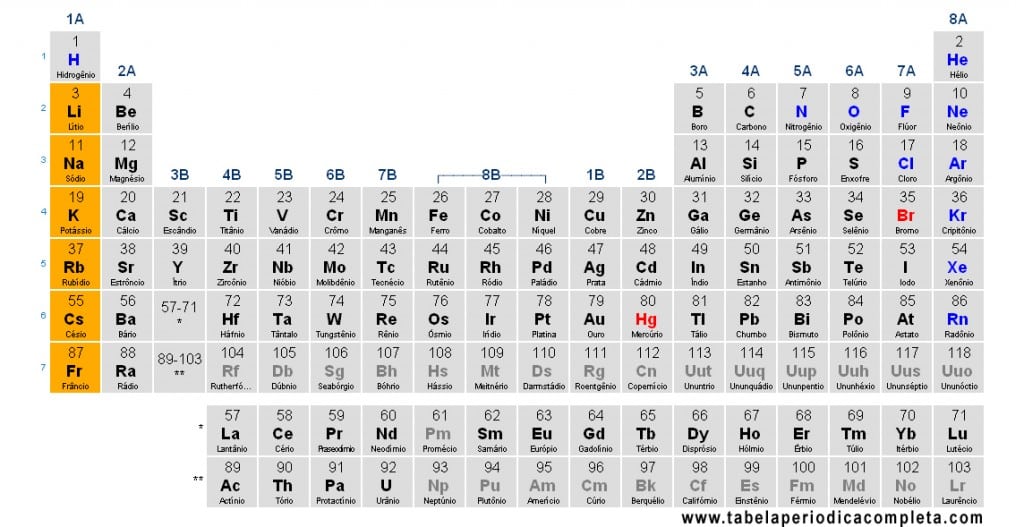The Alkali Metals form group 1 (1A) of the Periodic Table. This family includes lithium (Li), sodium (Na), potassium (K), rubidium (Rb), cesium (Cs), and francium (Fr). Although hydrogen (H) appears at the top of the same column because of its ns¹ configuration, it is not classified as an alkali metal.
Main characteristics
- Soft metals (can be cut with a knife), with low density (Li, Na, and K are less dense than water), low melting points, and excellent conductivity.
- Highly reactive and strongly electropositive; they tend to lose one electron, forming M⁺ ions.
- Reactivity increases down the group: Li < Na < K < Rb < Cs (< Fr).
- Stored under mineral oil to prevent reaction with air or moisture.
Electronic configuration and periodic trends
All alkali metals have a valence configuration of ns¹. Moving down the group, the atomic radius and metallic character increase, while ionization energy and electron affinity decrease. This favors the formation of M⁺ cations and stronger reducing behavior.
Typical reactions
- With water: vigorous reactions forming hydroxides (MOH) and hydrogen gas (H₂). The solution becomes alkaline.
- With oxygen: form oxides (M₂O), peroxides (M₂O₂), or superoxides (MO₂), depending on the metal.
- With halogens: produce ionic halides (MX), which are highly soluble.
- With hydrogen: form ionic hydrides (MH), useful reducing agents.
Compounds and solubility
- Halides (NaCl, KCl): soluble, essential in biological and industrial processes.
- Nitrates (MNO₃) and carbonates (M₂CO₃): generally soluble; bicarbonates (MHCO₃) stable for Na and K.
- Hydroxides (MOH): strong bases (NaOH, KOH) widely used in industry.
Occurrence and extraction
- Sodium: abundant as halite (NaCl) and in brines; metal obtained by electrolysis.
- Potassium: occurs as sylvite (KCl) and in salts used for fertilizers.
- Lithium: found in brines and minerals (spodumene, lepidolite); extracted via chemical processes.
- Rubidium, cesium, and francium: much rarer; Cs found in pollucite, Fr is extremely rare and radioactive.
Applications
- Lithium: lithium-ion batteries, ceramics, and special glasses.
- Sodium: production of NaOH, Na₂CO₃, sodium vapor lamps, reducing agents, and heat exchangers.
- Potassium: fertilizers (KCl, K₂SO₄), KOH in chemical synthesis and liquid soaps.
- Rubidium/Cesium: atomic clocks, photoelectrodes, and research.
Safety
Because of their reactivity, especially with water and moisture, alkali metals must be handled with protective measures and stored under oil. Reactions release heat and H₂ gas, which can ignite. Their hydroxides are caustic and require care.
Hydrogen: why is it not an alkali metal?
Although it has a single valence electron (ns¹) and appears at the top of group 1, hydrogen is a non-metal under normal conditions. It forms covalent molecules (H₂) and cations/protons in solution. Its chemical and physical properties differ greatly from those of the alkali metals, so it is treated separately.
Curiosities (flame colors)
- Lithium: crimson red
- Sodium: intense yellow
- Potassium: lilac
- Rubidium: red-violet
- Cesium: blue-violet
FAQ – Frequently Asked Questions about Alkali Metals
Which are the Alkali Metals?
Lithium (Li), sodium (Na), potassium (K), rubidium (Rb), cesium (Cs), and francium (Fr). Hydrogen is not an alkali metal.
Why do they react so strongly with water?
Because they are highly electropositive and quickly release their valence electron, forming hydroxide (MOH) and hydrogen gas (H₂) in an exothermic reaction.
Which is more reactive: sodium or potassium?
Potassium is more reactive. In general, reactivity increases down the group (Li < Na < K < Rb < Cs).
Are all alkali metal compounds soluble?
Many are, but not all. Halides, nitrates, hydroxides, carbonates, and bicarbonates of Na/K are usually soluble, with some exceptions depending on the anion.
Why must they be stored under oil?
To prevent reactions with moisture and oxygen in the air, which may cause ignition or localized explosions.
Does hydrogen belong to group 1?
It appears at the top because of its ns¹ configuration, but it is a non-metal and does not share the same properties as Alkali Metals, so it is treated separately.
